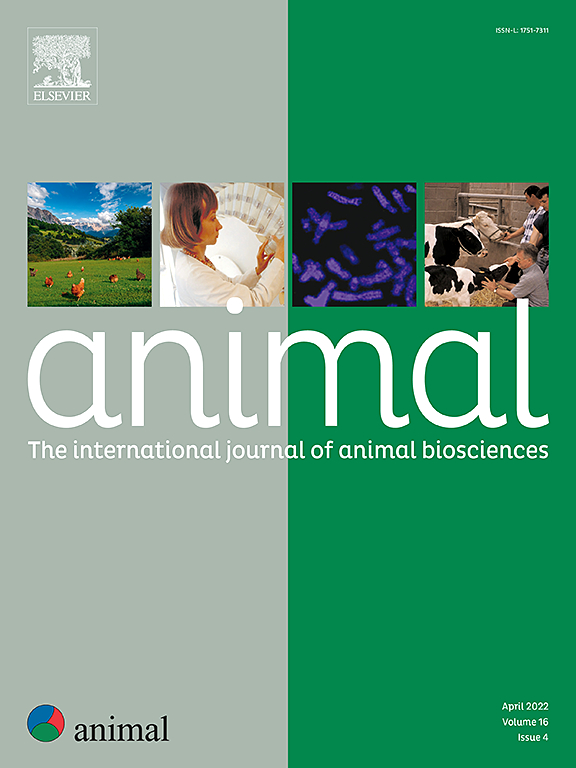相同能量基质下不同蛋白质和碳水化合物水平黄粉虫幼虫的生产性能
IF 4.2
2区 农林科学
Q1 AGRICULTURE, DAIRY & ANIMAL SCIENCE
引用次数: 0
摘要
黄粉虫(tenbrio molitor)幼虫能有效地将废物转化为高质量的昆虫蛋白。然而,黄粉虫幼虫的具体营养需求在很大程度上仍不清楚。因此,本研究旨在从蛋白质和碳水化合物的含量方面研究饲养黄粉黄虫幼虫的最佳底物组成。共配制了5种等能质和等脂质底物,蛋白质含量为10% ~ 30%,碳水化合物含量为29.72 ~ 68.15%,蛋白质与碳水化合物的比例为1:1 ~ 1:7。在恒温培养箱中,在控制条件下,每个培养皿中饲养3个重复的幼虫(长度约为10 mm,每个重复15 g,每箱约1 297只幼虫),每个培养皿饲养8周,然后收获。结果表明,在蛋白质含量为15%(碳水化合物含量为58.34%)、蛋白能比为10.19 g/MJ的底物条件下,幼虫最终产量最高,食物转化效率最高,底物蛋白质转化效率最高。此外,饲喂蛋白质含量较高的基质对幼虫生长有不利影响。综上所述,本研究得出结论,为了在保证底物资源最佳利用和最大限度降低饲养成本的同时获得高产,建议使用蛋白质含量为15%、蛋白质与碳水化合物比为1:5、蛋白质与能量比为6.82 g/MJ的底物。本文章由计算机程序翻译,如有差异,请以英文原文为准。
Productive performance of yellow mealworm larvae in different protein and carbohydrate levels in the same energy substrate
Yellow mealworm (Tenebrio molitor) larvae can efficiently convert waste into high-quality insect protein. However, the specific nutritional requirements of Tenebrio molitor larvae remain largely unclear. Therefore, this study aimed to investigate the optimal substrate composition in terms of protein and carbohydrate content for rearing Tenebrio molitor larvae for food and feed applications. Five isoenergetic and isolipid substrates were formulated, with protein content ranging from 10 to 30%, carbohydrate content ranging from 29.72 to 68.15%, and a protein-to-carbohydrate ratio varying from 1:1 to 1:7. Three replicates of larvae (approximately 10 mm in length, 15 g per replicate, approximately 1 297 larvae per box) were fed each substrate for 8 weeks under controlled conditions in a constant-temperature incubator and subsequently harvested. The results demonstrated that larvae fed on a substrate containing 15% protein (corresponding to 58.34% carbohydrate content) and a protein-to-energy ratio of 10.19 g/MJ achieved the highest final yield, the most efficient food conversion, and the greatest substrate protein conversion efficiency. Additionally, feeding substrates with higher protein content negatively impacted larval growth. In summary, this study concluded that to achieve high yields while ensuring optimal utilisation of substrate resources and minimising feeding costs, it is recommended to use a substrate with 15% protein content, a protein-to-carbohydrate ratio of 1:5, and a protein−to−energy ratio of 6.82 g/MJ.
求助全文
通过发布文献求助,成功后即可免费获取论文全文。
去求助
来源期刊

Animal
农林科学-奶制品与动物科学
CiteScore
7.50
自引率
2.80%
发文量
246
审稿时长
3 months
期刊介绍:
Editorial board
animal attracts the best research in animal biology and animal systems from across the spectrum of the agricultural, biomedical, and environmental sciences. It is the central element in an exciting collaboration between the British Society of Animal Science (BSAS), Institut National de la Recherche Agronomique (INRA) and the European Federation of Animal Science (EAAP) and represents a merging of three scientific journals: Animal Science; Animal Research; Reproduction, Nutrition, Development. animal publishes original cutting-edge research, ''hot'' topics and horizon-scanning reviews on animal-related aspects of the life sciences at the molecular, cellular, organ, whole animal and production system levels. The main subject areas include: breeding and genetics; nutrition; physiology and functional biology of systems; behaviour, health and welfare; farming systems, environmental impact and climate change; product quality, human health and well-being. Animal models and papers dealing with the integration of research between these topics and their impact on the environment and people are particularly welcome.
 求助内容:
求助内容: 应助结果提醒方式:
应助结果提醒方式:


